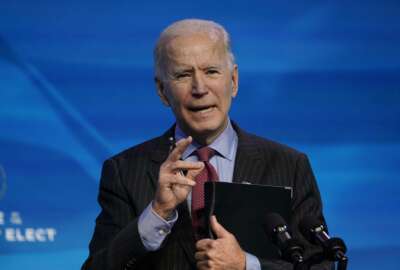OMB finds agency data needs work to understand inequality in public-facing services
The Biden administration is calling on agencies to identify bottlenecks that make their public-facing services inaccessible to certain demographics.
The Biden administration is calling on agencies to identify bottlenecks that make their public-facing services inaccessible to certain demographics, and to collect more reliable data on how programs could better serve certain populations.
It’s a big project for agencies, one that the Office of Management and Budget says will build on a “nascent body of work” in government around data science, program evaluation, and change management.
But acting OMB Director Shalanda Young said the federal government, as the country’s largest employer and buyer of goods, need to better understand its blindspots when providing everything from medical research, to public housing, to disaster assistance.
“Too many people have been historically underserved and experienced marginalization, disenfranchisement, and lost opportunity,” Young wrote in a blog post last Friday.
President Joe Biden, as part of the executive order on diversity, equity and inclusion he signed on his first day in office, is directing OMB and the White House’s Domestic Policy Council to understand agency best practices in this field of work.
The executive order gave agencies until Aug. 8 to submit equity assessments, designed to “shine a spotlight on barriers, gaps, and obstructions that routinely affect some, but not all individuals, including communities of color, LGBTQ+ populations, and those living with one or more disabilities.”
OMB is encouraging agencies to focus their assessments on “high-impact services,” including programs with a high volume of transactions or that cover a significant amount of agency spending. By January 2022, agencies will provide the Domestic Policy Council with actions plans outlining the next steps to improve the equity of their services.
OMB, in a report outlining methods to identify equity in agency programs, finds agencies have some tools to assess the equity of their work, but need expertise across several disciplines to better evaluate the equity of their programs.
“Fully capitalizing on the catalytic nature of the [executive] order will require investments in ongoing learning and training of the federal workforce and in hiring and developing key functions and skillsets in the federal workforce, especially personnel with specialized training in data science, evaluation, human-centered and service design, and equity-focused change management,” the report notes.
In addition to investing in the federal workforce, OMB found agencies generally don’t have the data needed to understand how they serve the public across demographics such as gender identity, race, ethnicity, sexual orientation, religion, disability, income or education.
While many agencies have an abundance of administrative data — data gathered over the course of implementing federal programs and services — many agencies told OMB “they do not yet have structures, processes, or mechanisms to deploy that data for purposes of assessing equity.”
The Equitable Data Working Group, established under the executive order, found three common barriers that agencies experience in conducting equity assessments:
- Underutilized data – Agencies have the data needed to answer a question or respond to an equity issue, but encounter barriers trying to use the data.
- Inaccessible data – Access to data is restricted by statute, in order to avoid compromising individuals’ privacy.
- Missing data – Data needed to answer a question or respond to an issue does not exist at all, or is very low quality.
Under the executive order, the working group will submit a report to the assistant to the president for domestic policy with recommendations on how to promote inter-agency sharing of data that would improve equity assessment.
The OMB report also found agencies often have gaps in their data when individuals hesitate to provide demographic information about themselves or their families.
“Where trust is low, information response may be truncated,” the OMB report states.
The Associated Press, for example, reports 2020 census respondents omitted responses on 10-20% of questions asking about sex, race, Hispanic background, family relationships and age, even when providing a count of the number of people living in the home, according to documents released by the Census Bureau.
Understanding bottlenecks in government services
The administration is also looking to understand bottlenecks in agency processes that prevent certain demographics from accessing government services at a higher rate than the general public.
OMB, for example, found 14 million low-income Americans paid for private tax-filing services last year, even though they qualified for free tax filing through a “confusing and overly-complex government program overseen by the IRS.”
The report also notes the average call wait time to reach the Social Security Administration in 2019 was more than 20 minutes, and over 10% of calls to SSA field offices went unanswered. Meanwhile, the average wait time at an SSA field office was almost 30 minutes.
OMB said the COVID-19 pandemic underscored “the immense public costs of not being customer-focused when designing and implementing public benefits programs,” noting widespread frustration from elderly Americans trying to sign up for a COVID-19 vaccine online in the early stages of vaccine distribution.
“Research indicates that where there are administrative burdens, they do not fall equally on all entities and individuals, leading to disproportionate underutilization of critical services and programs, as well as unequal costs of access, often by the people and communities who need them the most,” the report states.
The report also found steps agencies take to verify the identities of customers can also result in unequal access to those services. OMB said agencies can do more to automate eligibility checks for individuals seeking benefits, or move more of the verification work to back-end, internal processes that don’t require more work from customers.
OMB recommends agencies conduct “burden audits” to better understand which bottlenecks prevent vulnerable populations from accessing government services and run burden-reduction sprints in partnership with the U.S. Digital Service, the Federal Customer Experience Team and the Office of Performance and Personnel Management
Copyright © 2024 Federal News Network. All rights reserved. This website is not intended for users located within the European Economic Area.
Jory Heckman is a reporter at Federal News Network covering U.S. Postal Service, IRS, big data and technology issues.
Follow @jheckmanWFED






